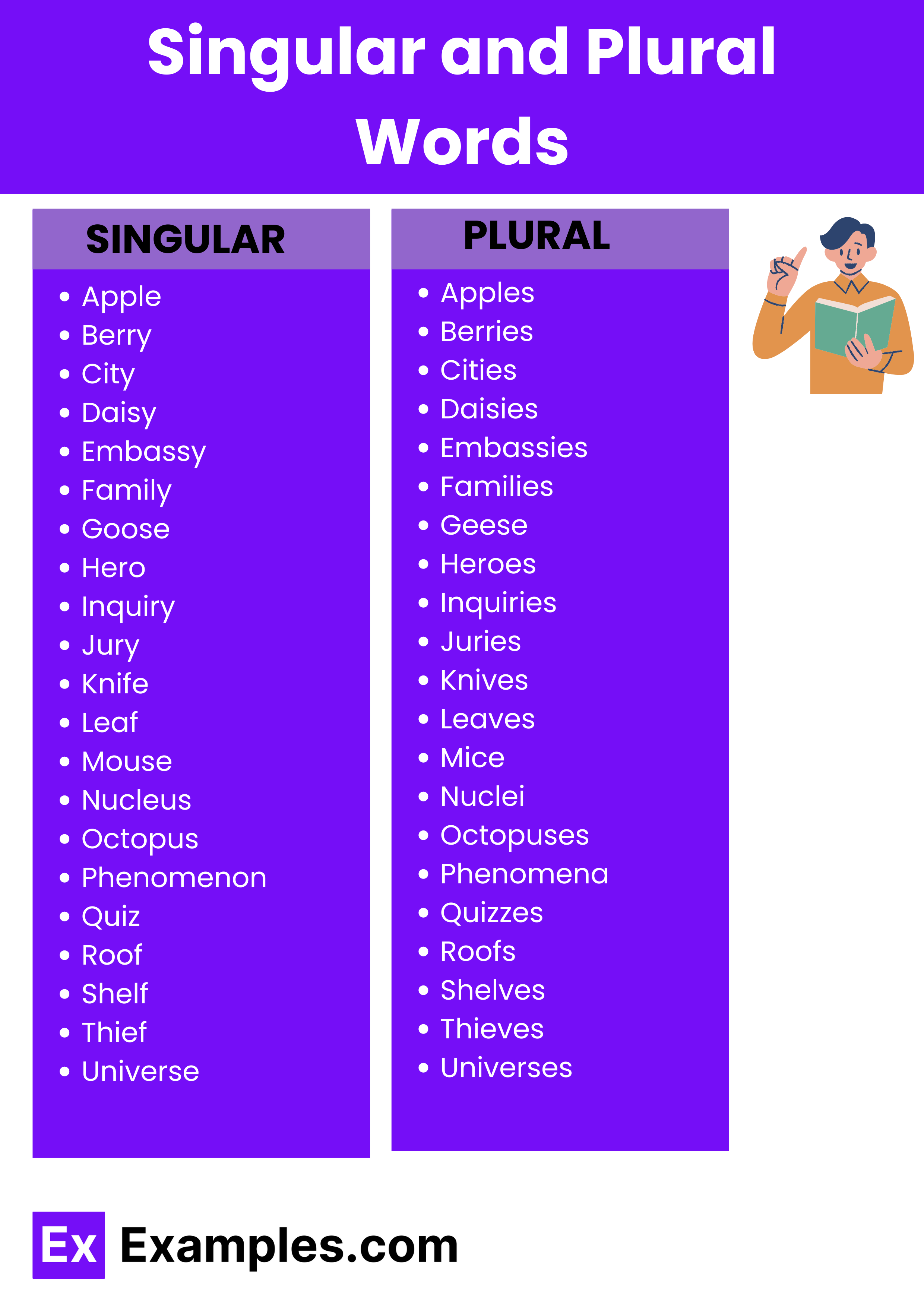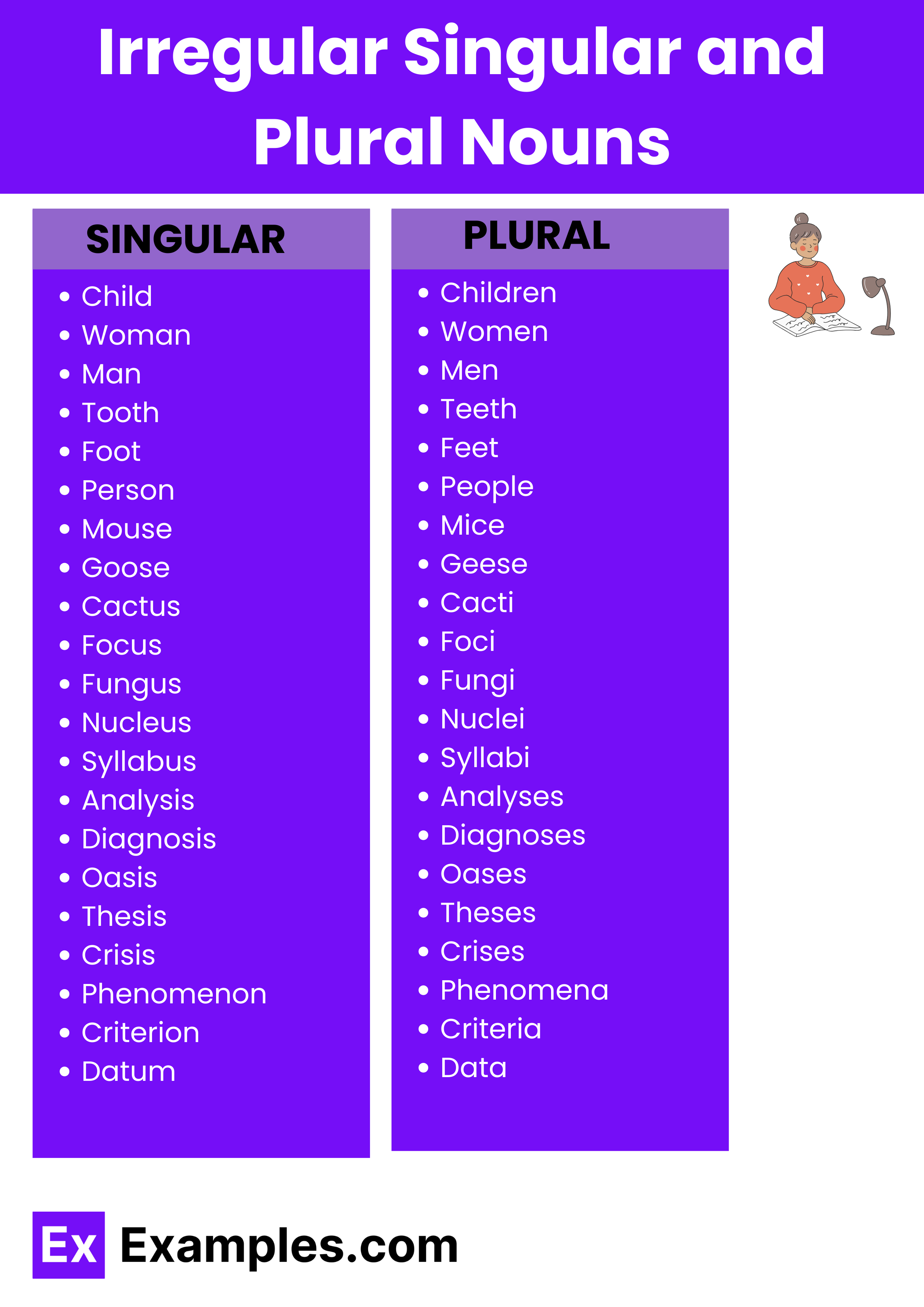450+ Singular & Plural Words List, Meaning, PDF
In the intricate dance of language, singular and plural words serve as fundamental steps, guiding the rhythm of communication. Singular words identify a single entity, while their plural counterparts embrace multiplicity, adding dimension to our expressions. This distinction is not just a grammatical formality but a reflection of the world’s diversity captured through language. Understanding singular and plural forms empowers us to navigate conversations with precision, painting vivid pictures with our words. Join us as we explore the dynamic interplay between these linguistic building blocks.
Download Most Commonly Singular & Plural Words - PDF
What are Singular & Plural Words?

List of Singular and Plural Words
| Singular | Plural |
|---|---|
| Apple | Apples |
| Berry | Berries |
| City | Cities |
| Daisy | Daisies |
| Embassy | Embassies |
| Family | Families |
| Goose | Geese |
| Hero | Heroes |
| Inquiry | Inquiries |
| Jury | Juries |
| Knife | Knives |
| Leaf | Leaves |
| Mouse | Mice |
| Nucleus | Nuclei |
| Octopus | Octopuses |
| Phenomenon | Phenomena |
| Quiz | Quizzes |
| Roof | Roofs |
| Shelf | Shelves |
| Thief | Thieves |
| Universe | Universes |
| Vortex | Vortices |
| Wife | Wives |
| Xerox | Xeroxes |
| Youth | Youths |
| Zebra | Zebras |
List of Irregular Singular and Plural Nouns
| Singular | Plural |
|---|---|
| Child | Children |
| Woman | Women |
| Man | Men |
| Tooth | Teeth |
| Foot | Feet |
| Person | People |
| Mouse | Mice |
| Goose | Geese |
| Cactus | Cacti |
| Focus | Foci |
| Fungus | Fungi |
| Nucleus | Nuclei |
| Syllabus | Syllabi |
| Analysis | Analyses |
| Diagnosis | Diagnoses |
| Oasis | Oases |
| Thesis | Theses |
| Crisis | Crises |
| Phenomenon | Phenomena |
| Criterion | Criteria |
| Datum | Data |
| Medium | Media |
| Alumnus | Alumni |
| Atlas | Atlases |
| Axis | Axes |
| Batch | Batches |
| Bush | Bushes |
| Cliff | Cliffs |
| Reef | Reefs |
| Roof | Roofs |
| Chef | Chefs |
| Belief | Beliefs |
Examples of Sentences with Singular Nouns
Discover the power of singular nouns in sentence construction through our curated examples. Singular nouns, representing a single entity, are pivotal in crafting clear and precise sentences. They lay the foundation for effective communication, emphasizing the subject of discussion. This exploration not only enhances vocabulary but also sharpens grammatical accuracy, crucial for both beginners and seasoned writers.
- Apple: The apple on the table is ripe.
- Bird: A bird perched on the windowsill.
- Car: His car broke down yesterday.
- Dog: The dog barked all night.
- Elephant: An elephant has a long trunk.
- Flower: The flower bloomed beautifully.
- Guitar: The guitar was out of tune.
- House: Their house is on the corner.
- Island: The island is uninhabited.
- Jacket: My jacket is too tight.
- Kite: The kite flew high in the sky.
- Lamp: The lamp flickered before going out.
- Mountain: The mountain is covered in snow.
- Notebook: Her notebook is full of ideas.
- Ocean: The ocean was calm today.
- Pencil: This pencil needs sharpening.
- Queen: The queen addressed her subjects.
- River: The river flows into the sea.
- Star: A star twinkled in the night sky.
- Tree: The tree shed its leaves.
- Umbrella: My umbrella broke in the wind.
- Violin: The violin produced a haunting melody.
- Whale: A whale breached the surface.
- Xylophone: The xylophone had bright colors.
- Yacht: The yacht sailed at dawn.
- Zebra: A zebra has stripes for camouflage.
- Book: The book was a thrilling read.
- Chair: That chair is antique.
- Desk: The desk was cluttered with papers.
- Egg: The egg cracked open easily
Examples of Sentences with Plural Nouns
Plural nouns represent more than one person, place, thing, or idea, making them a cornerstone of English grammar. Understanding their usage through examples helps in mastering the art of effective communication. In this article, we will explore the functionality of plural nouns within sentences, offering insights into their diverse applications and meanings. We aim to enhance your grammar skills, particularly in identifying and using plural nouns correctly, which is essential for writing and speaking English fluently.
- Cats love to chase mice. (Cats and mice are plural nouns indicating more than one cat and mouse.)
- The children play in the parks every evening. (Children and parks refer to multiple kids and outdoor areas.)
- Books are the best source of knowledge. (Books implies more than one book.)
- The teachers gave the students homework. (Teachers and students denote a group of educators and learners.)
- Balloons add color to parties. (Balloons and parties suggest multiple balloons and more than one celebration.)
- Apples are rich in vitamins. (Apples refers to more than one apple.)
- Birds migrate in flocks. (Birds and flocks represent multiple birds and groups.)
- Cars fill the streets during rush hour. (Cars and streets indicate numerous vehicles and roads.)
- Gardens are full of flowers. (Gardens and flowers denote multiple garden areas and blooms.)
- Buses are a convenient mode of transport. (Buses and transport imply more than one bus and means of transportation.)
- The museums display ancient artifacts. (Museums and artifacts refer to several museums and objects.)
- Dogs are loyal animals. (Dogs and animals suggest more than one dog and animal.)
- Cities have diverse cultures. (Cities and cultures denote multiple urban areas and cultural practices.)
- Beaches are popular destinations. (Beaches and destinations imply multiple coastal areas and places.)
- Lakes are surrounded by trees. (Lakes and trees represent multiple bodies of water and plants.)
- Stars light up the nights. (Stars and nights indicate numerous celestial bodies and night times.)
- Computers have revolutionized workplaces. (Computers and workplaces suggest multiple electronic devices and work settings.)
- Mountains offer breathtaking views. (Mountains and views denote several peaks and scenes.)
- Rivers flow into the oceans. (Rivers and oceans refer to multiple rivers and large bodies of water.)
- Photographs capture moments. (Photographs and moments imply multiple images and time points.)
- Countries have unique traditions. (Countries and traditions represent several nations and customs.)
- Factories produce goods. (Factories and goods denote multiple manufacturing sites and products.)
- Instruments create beautiful melodies. (Instruments and melodies suggest multiple musical devices and tunes.)
- Universities offer various courses. (Universities and courses indicate several higher education institutions and programs.)
- Islands are surrounded by waters. (Islands and waters refer to multiple landforms and water bodies.)
- Novels tell fascinating stories. (Novels and stories denote multiple fictional works and narratives.)
- Athletes compete in sports. (Athletes and sports imply multiple sportspeople and games.)
- Forests are home to wildlife. (Forests and wildlife represent large wooded areas and animal populations.)
- Friends share memories. (Friends and memories suggest multiple companions and recollections.)
- Bridges connect cities. (Bridges and cities indicate several structures and urban areas.)
Rules of Singular and Plural
1. Adding -s
- Singular: Cat
- Plural: Cats
Rule: For most nouns, simply add “-s” to the end to make them plural.
2. Adding -es to Nouns Ending in -s, -ss, -sh, -ch, -x, or -z
- Singular: Bus
- Plural: Buses
Rule: When nouns end in -s, -ss, -sh, -ch, -x, or -z, add “-es” to form the plural.
3. Changing -y to -ies If a Consonant is Before the -y
- Singular: Baby
- Plural: Babies
Rule: If a noun ends in a consonant followed by “-y,” change the “-y” to “-ies” for the plural form.
4. Nouns Ending in -o: Add -s or -es
- Singular: Auto
- Plural: Autos
- Singular: Tomato
- Plural: Tomatoes
Rule: For nouns ending in -o, add “-s” or “-es.” The rule varies, so it’s often best learned through practice and memorization.
5. Irregular Plurals
- Singular: Child
- Plural: Children
Rule: Some nouns do not follow regular pluralization rules and must be memorized.
6. Nouns Ending in -f or -fe: Change to -ves
- Singular: Wolf
- Plural: Wolves
Rule: For some nouns ending in -f or -fe, change the ending to “-ves” to make the noun plural.
7. Pluralizing Compound Nouns
- Singular: Mother-in-law
- Plural: Mothers-in-law
Rule: For compound nouns, usually, the primary noun is pluralized.
8. Invariable Nouns
- Singular: Sheep
- Plural: Sheep
Rule: Some nouns have the same form for both singular and plural. These are known as invariable or uncountable nouns
Understanding singular and plural words is foundational to mastering English grammar. This guide illuminates the rules and exceptions, providing clarity on their usage through practical examples. Embracing these concepts enhances communication skills, enabling precise and articulate expression. Whether singular or plural, each word plays a pivotal role in the rich tapestry of language, shaping our thoughts and conversations.
FAQs
How do you form plurals in English?
Most plurals are formed by adding “s” or “es” to the singular word.
Can all nouns be made plural?
Most nouns have plural forms, but some (like “information”) do not and are considered uncountable.
What are irregular plural forms?
Irregular plurals change spelling when made plural, such as “man” to “men” and “child” to “children.”
How do plurals work with compound words?
For compound words, usually the main noun changes, as in “mothers-in-law” and “passers-by.”
Why is understanding singular and plural important?
Understanding these forms helps in crafting accurate and grammatically correct sentences, crucial for effective communication.





